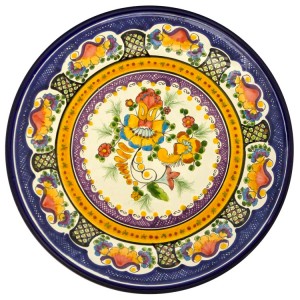The eighteenth-century chronicler Ferrindez de Echeverria y Veytia claimed that Talavera was the finest pottery produced in the City of Puebla, and wrote about ‘these workshops of white earthenware called Talavera that can be found within the city limits. With a white clay…they make all kinds of pieces that are so polished and original, so well glazed and painted that they are just as good as any imported from Europe, which are copied perfectly.
Today, tin-glazed pottery from Puebla is still referred to as Talavera, but no one seems to agree about the origin of this term. A rather obsolete theory affirms Talavera was the surname of the first potter in Puebla to produce a ceramic piece of this kind, but this theory has yet to produce any documentary evidence. Another states that it was given this name in honor of those potters who came from Talavera de la Reina in Toledo to teach techniques to their counterparts in Puebla.
Resorting to oral tradition, some scholars have affirmed that Dominican friars in Puebla, who were aware of a lack in local skills (and were anxious to tile their monastery) asked the Order in Tdlavera de la Reina to send friars who could teach potters the art of tin-glazed ceramics. There are no documents, however, to support this belief. The most widely held opinion is that Talavera was given this name very simply because of its similarity to the earthenware produced in Talavera de la Reina.
The most recent theory is that the term was first used in 1682 when clauses were added to the Ordinances laid down by the potter’s guild in Puebla. One of these clauses stated that ‘fine pottery should imitate earthenware from Talavera…’ which is to say that the object should be so similar to the other that only with great difficulty can one tell the original apart from the counterfeit.” Other scholars claim, however, that not one of these theories or legends proves why pottery from Puebla is called Talavera. and have consequently insisted on the term majolica or white earthen ware. Majolica was the Italian name given to glazed porous pottery from Mallorca, which soon came to designate any similar ceramic piece. Though the term Talavera is no longer used in Spain, it is still very much alive in Mexico, especially in Puebla where potters continue to use essentially the same methods as their ancestors.
Indeed, the techniques involved in the making of Talavera have hardly changed at all since colonial times. Potters used two kinds of clay: a black variety extracted from deposits in the hills of Loreto and Guadalupe and a pink clay which was found near Totimehuacan. Once the clay’s had been sifted to get rid of all foreign matter—such as plant debris and pebbles—they were mixed and then left in water tanks “to rot”. The plasticity and quality of the clay improved the longer they were left. Before the potter could work the clay he had to remove all excess water. He then began to wedge the clay by plating it on a brick floor in a covered area where it was “treaded” barefoot to achieve an even consistency.
The wedging was finished-off by hand and the clay was then divided into lumps of different sizes: the bigger ones were called tallos (reeds) and the smaller ones hulas (bullets). The potter worked the smaller lumps on the wheel to create numerous objects and used molds for making tiles. Once the pieces were completed. they were left in a closed room for a long period of time to ensure that they dried evenly. They were then fired in a wood-fueled kiln. After this firing—which lasted from ten to twelve hours each piece was examined carefully in order to separate the good pieces from those with imperfections or those that had been fired unevenly_ net-were then covered with a white glaze—made of a tin and lead base—which gave the enamel finish to each piece, According to the seventeenth-century ordinances, the proportion of glaze lo be used was 1 arroba (25 lbs.) of lead to 6 afro-bas of tin for extra-fine pieces, and 1 arroba of lead to 2 of tin for ordinary white earthenware.
Once the glaze had dried, pieces were decorated with different designs. The range of choices was also designated by the Ordinances and would vary depending on the quality of the ceramic piece. Potters prepared paints from x-ariaus mineral pigments. Pieces were then ready for the last firing which would take up to forty hours.
Article excerpt from Artes de Mexico Magazine – June 1992
